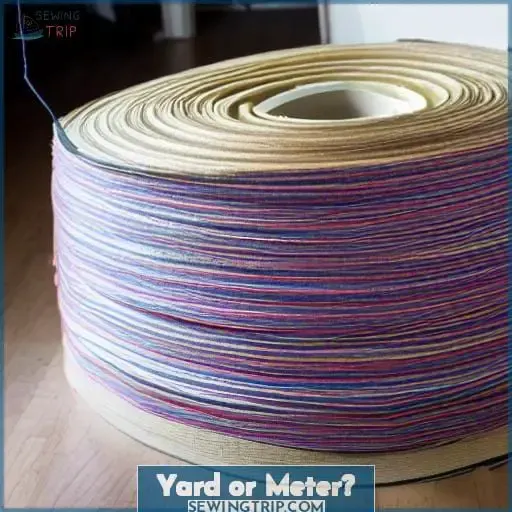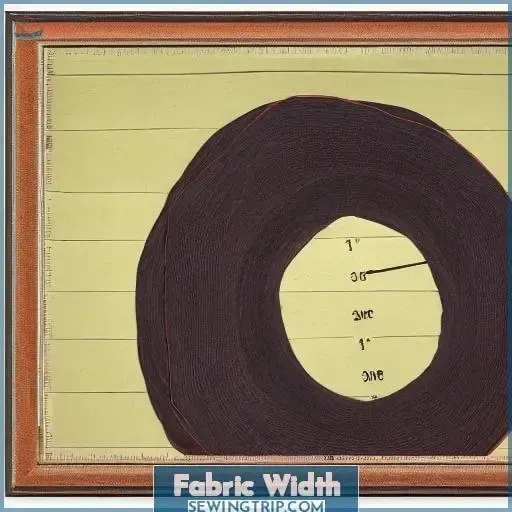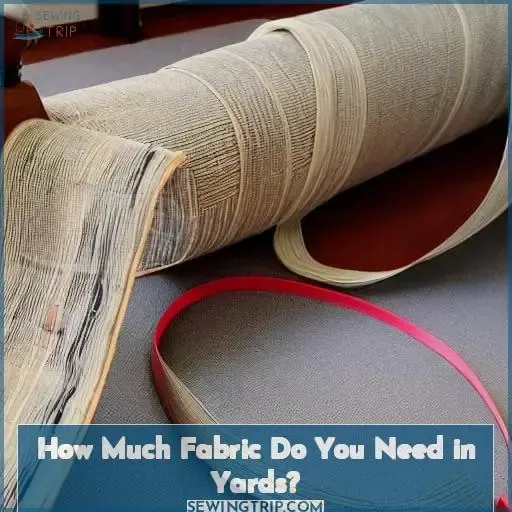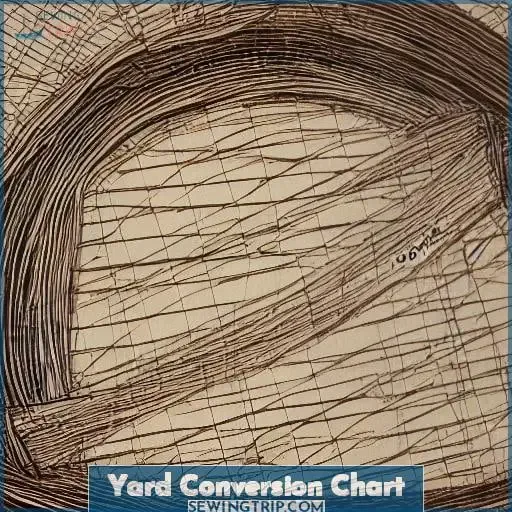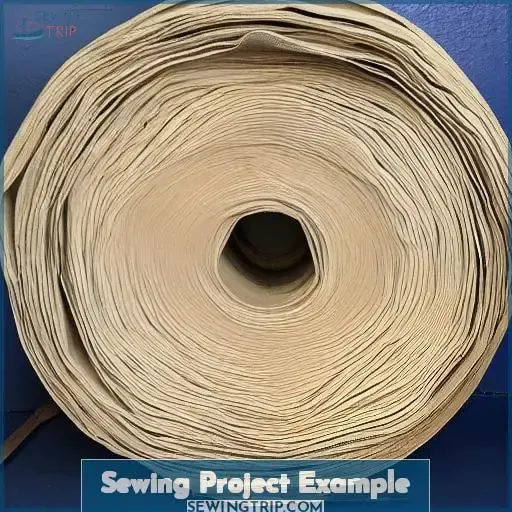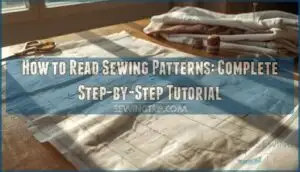This site is supported by our readers. We may earn a commission, at no cost to you, if you purchase through links.

So, how big is a yard of fabric in inches? A yard of fabric is equal to 36 inches.
It’s important to understand the basics of what makes up a yard of fabric to make sure your next project turns out just right. With this information, you can now confidently measure and purchase fabric for your sewing or crafting projects.
Table Of Contents
What is a Yard of Fabric?
Understanding the measurement of a yard of fabric is essential for completing projects with precision and accuracy. A yard of fabric is 36 inches or 3 feet in length, which can affect the cost depending on its weight, type, quality and care that goes into it.
There are different widths to consider when measuring a square yard or square feet – most commonly 44/45 inches and 60 inches wide. Additional widths such as 12”, 16, 24”, 30, 36, 38”, 42, 48, 54, 58, 59, 70, 72, 108, 120 can also be found but may not always be usable due to selvages or borders.
When buying by the piece from stores they might divide one yard into fractions like fat quarters (half yards). Depending on where you purchase your fabric from will determine if there’s a standard number of yards on each bolt; however, it’s important to always check dimensions before using for any project!
How to Measure a Yard of Fabric
To accurately determine the size of your fabric project, use a measuring tape to measure out 36 inches of material – that’s one yard! The width of the fabric can vary depending on its type and where it is purchased. Different types of fabrics have varying widths, such as 44/45 inches, 60 inches, 12-16-24-30-36 inch wide lace fabric, or even wider upholstery fabric at 54 or more.
It’s important to consider shrinkage when purchasing any type of material for a project since certain fabrics might not be usable due to selvages and borders.
Here are four things you need to know about how big is a yard in imperial system:
- A single yard measures 36 x 45 but can vary in length based on its width;
- Fabric weights including cotton bedding can cover queen beds without seams;
- Purchased by length or piece with fractions like half yards & fat quarters available;
- Conversion charts help convert between different units (inches, feet etc).
Knowing the exact dimensions before using it ensures accuracy for success in projects involving both small pieces like quilting blocks as well as larger ones such as curtains & duvets which require precise measurements and calculations!
Yard or Meter?
Yard or meter? Decide whether you need yards or meters—the choice is yours! Yards of fabric are used for many projects—clothing, accessories, home decor. You need to understand how many linear yards make up a piece, plus its width. Fabric weaves, non-woven fabrics, and pattern selection all require metric system measurements when calculating size requirements.
When dyeing or stitching techniques are involved, it’s crucial to know the exact size of a yard of fabric before beginning. This prevents wasting time and money due to miscalculations. Knowing exactly how much material is needed ensures success when selecting pieces for any craft or sewing endeavor.
How is Fabric Measured?
Understanding how fabric is measured can help you determine the best amount of material for your project. Fabric grades, types, weights and gauges are all factors to consider. A yard of cotton quilting weight fabric will measure differently than a yard of silk charmeuse or velvet upholstery fabric. The finishes on fabrics such as satin and lace may also affect their measurements, so make sure they’re accounted for.
A handy chart or calculator can give you accurate conversion values between inches and yards. This is helpful if you want to know exactly how much material you’ll end up with before buying it.
There are many online resources available, including YouTube videos explaining the process in detail, and helpful charts illustrating various conversions. This makes it easier for sewers at any level to accurately calculate their own measurements without prior knowledge.
Fabric Width
When discussing fabric width, it’s important to note that the most common standard widths are 44/45 inches and 60 inches. Wider fabrics, such as cotton for bedding, can cover a queen-sized bed without seams. Narrower fabrics, like lace or interfacing, usually measure less than 36 inches wide.
Not all of the fabric’s full width may be usable due to selvages or borders.
Standard Fabric Widths
With a variety of fabric widths available, you can easily find the right size for any project. Standard fabric widths range from 12 to 120 inches, with common options being 44/45 and 60 inches. Lace fabrics and interfacing may be narrower, while upholstery fabrics are typically wider at around 54-60 inches or more.
The width of your chosen fabric affects the amount needed for your project, as well as how it drapes or hangs when used in clothing or home decor items such as curtains and tablecloths.
When shopping for yardage lengths at a fabric store, take note of not only the width but also other factors like fiber content, weave type (e.g. twill), sewing thread count/density per inch (higher is better), stretchiness if applicable (like with knit fabrics). These all impact how easy it is to work with during construction and the final results achieved once completed!
Wider Fabric
With wider fabric, you can craft clothing and home decor items that require less seams for a more professional finish. Upholstery fabric is typically 54 inches wide, but can also be 60 inches or wider. The exact dimensions of a yard of fabric depend on the width; for example, one yard of 36-inch-wide fabric will contain three pieces, while one yard of 60-inch wide cloth will contain five.
Fabric weaving and thread counts are important design considerations when selecting fabrics, as they determine the quality grade and type available in each width range. Wider fabrics offer more versatility due to their greater number of uses – from garments to bed linens – making them an ideal choice for anyone looking for specific types or grades without compromising on style or budgeting constraints.
It’s important to take into account selvage edges when measuring out your project’s needs, as these affect how many usable yards are included in your purchase; always check actual dimensions before buying!
Narrower Fabric
You can find more specialised options with narrower fabric, which is great for intricate projects. Fabric weaves such as lace and netting are often much narrower than regular width fabrics due to their delicate nature. These types of fabrics usually require smaller needle sizes to sew accurately.
Different fabric types will often have varying thread counts, from a low count of 40 per inch up to 120 or higher per inch, depending on the weave structure and desired project outcome.
When estimating yardage for these kinds of projects, it’s important to remember you may need extra fabric due to shrinkage factors. So always make sure there’s enough lengthwise along the straight edge when measuring out a section from your roll or bolt of material, if using larger quantities than what your pattern piece requires.
The US system commonly uses inches when measuring lengths; however, one full yard (36 inches) can also be converted into 3 feet. A handy resource tool online would be an easy-to-use Fabric Yardage Conversion chart. This provides useful information about converting measurements between yards and other units like meters, centimeters etc. This could help those who aren’t familiar with how many linear yards are associated within each unit in the US system’s measurement standards.
How Much Fabric Do You Need in Yards?
Are you trying to calculate how much fabric you need for a project? Knowing the size of a yard of fabric in inches can help. One yard is 36 inches long, and fat quarters are usually 18×22. Understanding these measurements will make it easier to determine the amount of material needed.
Calculating Fabric Amounts
To determine the amount of fabric you need for your project, use an easy-to-use Fabric Yardage Conversion chart. Consider the type of fabric and its width; certain fabrics come in different weights and require unique sewing terminology. Make sure to account for any shrinkage. Buy a bit extra in case any cutting errors happen during production.
This conversion chart helps you learn how to convert from the metric system of measurement into the imperial system of inches, so understanding a pattern’s instructions is easier! With these tips, measuring fabric swatches or large amounts is more efficient and accurate.
Fat Quarter
A fat quarter is a creative way to make the most of your fabric. It gives you four smaller pieces for the same amount of material. The term ‘fat quarter’ refers to one-fourth of a yard in length and twice as wide due to its different cutting dimensions. From one yard of fabric, you can get four fat quarters in varying lengths depending on the type or pattern layout chosen.
When considering which type or width to buy, it’s important to consider quality materials used (thread count), color variations, fading characteristics over time when exposed to sunlight/chemicals/detergents etc., and how much usable material will result from a single fat quarter versus buying wider fabrics.
Yard Conversion Chart
To help you quickly convert measurements, use a yard conversion chart. Visualize the length and width of fabric in inches. This step-by-step tutorial explains how to read the chart. You can accurately estimate fabric for sewing projects. It covers different textile types, like cotton, linen, silk, or synthetic fabrics with varying weights and patterns. The imperial tape provided allows comparison of different cuts against standard yardage dimensions.
Experienced sales attendants provide helpful tips on bolt widths when measuring out yards. This is at your local store or online shop. With this knowledge, it’s easier than ever before to plan ahead for small scale quilting projects or larger upholstery pieces.
Sewing Project Example
With a yard of fabric, you can create an array of stunning projects that will leave everyone in awe! Depending on the type and width of Fabric Types, it is possible to make anything from clothing items to home décor. For example, with a yard of 60-inch-wide fabric you could make at least three tank tops or two simple skirts.
Cutting Tips are essential when working with fabrics; be sure to cut along the grain line for optimal results. Make use of Sewing Tools such as your sewing machine and thread cutter which have become more precise over time, making them easier for novice seamstresses to use accurately.
Seam Allowances should also be taken into consideration when planning your pattern layout; this makes it simpler to calculate how much material is needed before beginning any project.
To maximize economical placing Pattern Layouts together onto a yard pieces, utilizing convenient Fabric Yardage Conversion Charts are helpful in converting measurements between inches, feet, yards, centimeters and meters, which helps ensure accuracy while cutting all types of materials.
Frequently Asked Questions (FAQs)
How do I know how much fabric I need for my project?
Choosing the right fabric for your project is key to success. With so many different materials, styles, and quality of fabrics available, it can be difficult to select the appropriate one.
Knowing how much material you need is just as important! To help ensure accuracy, it’s best to understand measurement units and calculate yardage estimation based on what type of fabric you need and its width.
There are a couple different ways that this can be done. If you want a full tutorial, we’ve got you covered with our helpful guide!
Is it common for fabric stores to give extra fabric in case of cutting mistakes?
It is common for fabric stores to give extra fabric in case of cutting mistakes. When buying, consider the quality and type of material, as well as where it came from. Use good measuring tapes or rulers to get accurate yardage requirements. Get more yards than needed, so if there’s inaccuracy, fewer yards will be wasted with careless cuts.
What is the difference between imperial and Chinese inches?
Comparing systems of measurements, imperial and Chinese metrics, can lead to confusion when buying fabric. Imperial inches are longer; a yard of 44-inch wide cotton may only measure 35 du201d in China. This affects project plans requiring precise cuts or accurate width measurements. It’s important to understand how these two systems might affect your plans, including knowing how big a yard of fabric is in both imperial and Chinese inches.
What is the most common width for fabric?
The most common widths for fabric are 44/45 inches and 60 inches. Other average widths include 12, 16, 24, 30, 36, 38, 42, 48, 54, 58, 59, 70, 72, 108 and 120 inches.
Lace fabric and interfacing are usually narrower. Cotton bedding can be wide enough to cover a queen bed without seams.
It’s important to remember that dimensions of a yard depend on the type of fabric. So it’s wise to check out a handy chart or conversion calculator when making straight cuts from your material selection.
How do I convert between centimeters and meters?
Knowing your metric measurements is essential for any sewing project, especially when it comes to fabric. As the old adage goes, measure twice and cut once. You’ll want to make sure you have all your conversions done accurately to get the right amount of fabric for a project.
To convert between centimeters and meters, divide by One meter is equal to 100 cm or 01 km.
You can also use this conversion method for yardage estimation. A square yard of fabric (3 ft. x 3 ft.) equals 9 sq. yds. or 81 sq. inches. Two-yard widths are usually 54 inches wide or 1½ running yds. long by 36 inches wide per linear yard, with no selvages included.
Conclusion
You’ve come a long way in understanding fabric measurement – it’s like learning how to construct a giant jigsaw puzzle. You’ve got the pieces, you just need to put them together in the right way. Attention to detail is key – you need to keep track of the length, width, and type of fabric to ensure you’re getting the right amount.
Once you’ve got the hang of it, you’ll be able to create beautiful projects with confidence. So go ahead – it’s time to take on your next fabric project with ease. Let’s get sewing!



